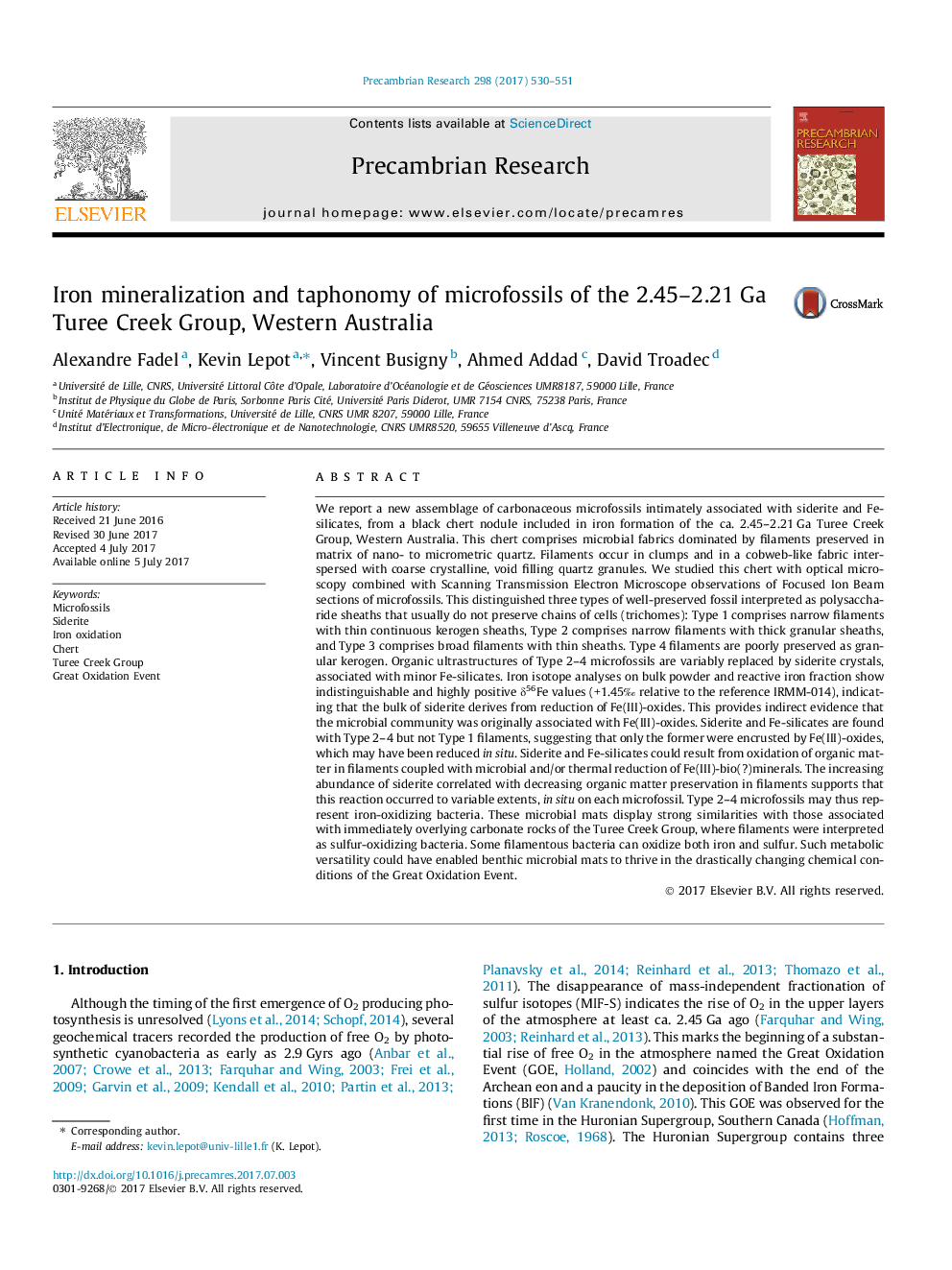| کد مقاله | کد نشریه | سال انتشار | مقاله انگلیسی | نسخه تمام متن |
|---|---|---|---|---|
| 5784812 | 1639577 | 2017 | 22 صفحه PDF | دانلود رایگان |
عنوان انگلیسی مقاله ISI
Iron mineralization and taphonomy of microfossils of the 2.45-2.21Â Ga Turee Creek Group, Western Australia
دانلود مقاله + سفارش ترجمه
دانلود مقاله ISI انگلیسی
رایگان برای ایرانیان
کلمات کلیدی
موضوعات مرتبط
مهندسی و علوم پایه
علوم زمین و سیارات
ژئوشیمی و پترولوژی
پیش نمایش صفحه اول مقاله

چکیده انگلیسی
We report a new assemblage of carbonaceous microfossils intimately associated with siderite and Fe-silicates, from a black chert nodule included in iron formation of the ca. 2.45-2.21 Ga Turee Creek Group, Western Australia. This chert comprises microbial fabrics dominated by filaments preserved in matrix of nano- to micrometric quartz. Filaments occur in clumps and in a cobweb-like fabric interspersed with coarse crystalline, void filling quartz granules. We studied this chert with optical microscopy combined with Scanning Transmission Electron Microscope observations of Focused Ion Beam sections of microfossils. This distinguished three types of well-preserved fossil interpreted as polysaccharide sheaths that usually do not preserve chains of cells (trichomes): Type 1 comprises narrow filaments with thin continuous kerogen sheaths, Type 2 comprises narrow filaments with thick granular sheaths, and Type 3 comprises broad filaments with thin sheaths. Type 4 filaments are poorly preserved as granular kerogen. Organic ultrastructures of Type 2-4 microfossils are variably replaced by siderite crystals, associated with minor Fe-silicates. Iron isotope analyses on bulk powder and reactive iron fraction show indistinguishable and highly positive δ56Fe values (+1.45Ⱐrelative to the reference IRMM-014), indicating that the bulk of siderite derives from reduction of Fe(III)-oxides. This provides indirect evidence that the microbial community was originally associated with Fe(III)-oxides. Siderite and Fe-silicates are found with Type 2-4 but not Type 1 filaments, suggesting that only the former were encrusted by Fe(III)-oxides, which may have been reduced in situ. Siderite and Fe-silicates could result from oxidation of organic matter in filaments coupled with microbial and/or thermal reduction of Fe(III)-bio(?)minerals. The increasing abundance of siderite correlated with decreasing organic matter preservation in filaments supports that this reaction occurred to variable extents, in situ on each microfossil. Type 2-4 microfossils may thus represent iron-oxidizing bacteria. These microbial mats display strong similarities with those associated with immediately overlying carbonate rocks of the Turee Creek Group, where filaments were interpreted as sulfur-oxidizing bacteria. Some filamentous bacteria can oxidize both iron and sulfur. Such metabolic versatility could have enabled benthic microbial mats to thrive in the drastically changing chemical conditions of the Great Oxidation Event.
ناشر
Database: Elsevier - ScienceDirect (ساینس دایرکت)
Journal: Precambrian Research - Volume 298, September 2017, Pages 530-551
Journal: Precambrian Research - Volume 298, September 2017, Pages 530-551
نویسندگان
Alexandre Fadel, Kevin Lepot, Vincent Busigny, Ahmed Addad, David Troadec,